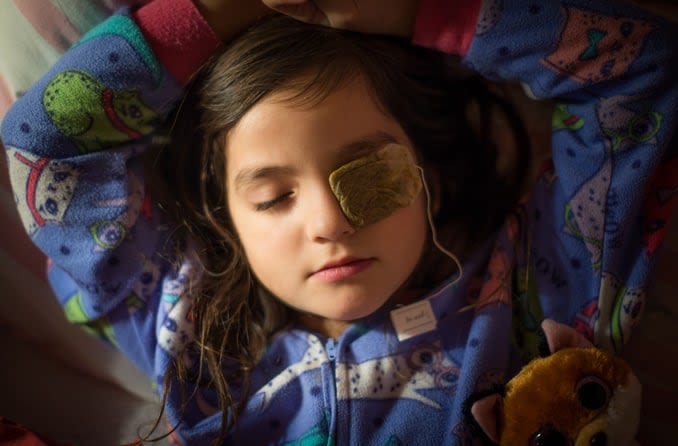10 home remedies for styes

When bacteria causes a stye — a painful, pimple-like bump — to form on your eyelid, it can be hard to ignore. While styes typically heal on their own, they can be treated at home to help speed up the healing process and prevent further infection.
To minimize how long your stye lasts, here are 10 stye home remedies you can try:
Stop wearing contact lenses
One of the first key steps in stye treatment is removing possible irritants in the eye area. Contact lenses and contact solutions can cause further irritation or dryness in the eyes, increasing discomfort and postponing the healing time.
Wear eyeglasses instead of contacts until the stye has healed to give the area room to breathe and avoid spreading bacteria. Once the stye has cleared, be sure to wear a fresh pair of contact lenses to avoid reinfection.
Clean the area (and keep it clean)
The area around the stye needs to be kept clean in order to heal properly. It is important to clean the area with products that are safe and mild enough to use in the eye area, such as:
Mild, hypoallergenic soap
Tear-free baby wash or shampoo
Saline solution
Gently scrub the area around the stye with a clean finger, a clean washcloth or a fresh cotton swab as needed.
Pause your makeup routine
Avoiding cosmetics around the site of a stye can help avoid further irritation and prevent the spread of bacteria from makeup brushes and tools. Once the stye has healed, use clean or new brushes and products to resume your makeup routine.
With or without a stye, eyes are sensitive and should be cared for appropriately. To use makeup safely around your eyes, eye care providers recommend that you:
Do not share your mascara, eyeliner or makeup brushes.
Wash your hands before applying makeup.
Wash or replace brushes and other tools regularly.
Throw out makeup that is defective or expired.
Use a warm compress
A warm compress can help relieve pain and irritation caused by a stye, as well as encourage a stye to drain on its own.
To use, dampen a clean washcloth with warm water and place it over the affected area for up to 10 minutes. The warmth will help bring the pus to the surface of the stye and dissolve oil inside the stye.
Note: Only use warm water, as water that is too hot can damage the skin and cause discomfort. Use a clean washcloth each time and never try to pop a stye.
Try warm tea bags
Like a warm compress, a warm tea bag can help reduce swelling around the affected area of the stye.
To use, steep a bag of tea in boiling water for a few minutes and then remove. Let the tea bag cool until it is comfortable against your skin, then place over the affected area for up to 10 minutes.
Use this technique on one or both eyes, but be sure to use a separate tea bag for each. It has been suggested that black tea is one of the most effective varieties of tea to use because of its antibacterial properties. However, there is no medical evidence that a tea bag is more effective than a clean washcloth.
Avoid popping, squeezing or picking at a stye
Squeezing, picking at or popping a stye can lead to further irritation and infection, which prolongs the healing process. If a stye is overwhelmingly irritating or interfering with your vision, it may be a good idea to see an eye care provider for professional treatment.
Apply light pressure
It’s important not to pop or squeeze a stye, but applying light pressure around the area can help encourage the stye to drain on its own. Using clean hands, gently massage the area around the stye. If you feel any discomfort, stop immediately.
If there’s any drainage from the stye, use a clean washcloth to gently clean the area with mild soap and water.
Apply ointment
An over-the-counter ointment designed for treating the eye area can help provide relief from a stye and promote faster healing. Using a clean finger or a cotton swab, apply a small amount of ointment to the eyelid of the affected eye.
When choosing an ointment, be sure to choose one that is safe for eyes and avoid any products with steroids or whitening agents. Can eye drops be used to treat a stye? Dryness or irritation that occurs after a stye has healed may be relieved with eye drops, but a topical ointment is more suitable for relieving discomfort caused by the stye itself.
Use an over-the-counter pain reliever
In addition to over-the-counter ointments, an over-the-counter pain reliever can help improve the inflammation and irritation caused by a stye. Ibuprofen will reduce both inflammation and pain because it is a non-steroidal anti-inflammatory (NSAID) drug. Either acetaminophen or ibuprofen may provide relief, especially when used in conjunction with the home remedies for styes above.
Seek medical treatment
If various stye remedies have not provided relief or if the condition worsens, schedule an appointment with an eye care provider. Styes can become infected and may require prescription medication, including a steroid shot. If the condition is serious enough, your ECP may need to drain the stye.
More stye articles
Page published on Tuesday, 17 May 2022
Medically reviewed on Thursday, 2 September 2021






